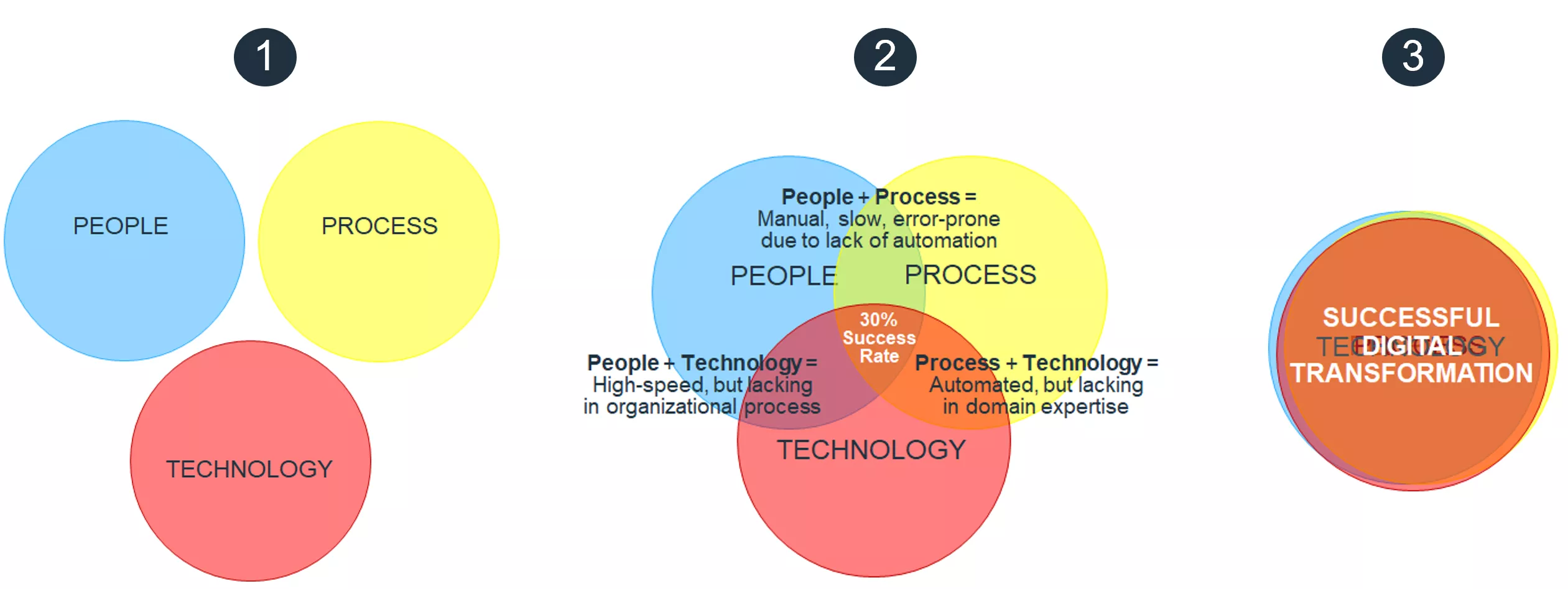The 2500-Year-Old, $900 Billion Lesson Haunting Digital Transformation
Despite spending more than a trillion dollars, 70% of corporate Digital Transformation projects are coming up short

Register for our May 19 Webinar:"Turning your IT Platform in a Digital Transformation Launch Pad"
Most people know the story of the Tower of Babel. It’s where we get the word “babble,” which means to talk in a manner that isn’t coherent or intelligible.
As the story goes, in the late 500s B.C., the people of Mesopotamia decided to build a grandiose tower tall enough to reach into the heavens. Displeased at such human hubris, God caused the architects, engineers, foremen and laborers to suddenly speak different languages… leaving them incapable of communicating with one another and forcing them to abandon their tower.

Thus, began an important lesson for companies everywhere that still applies 2500 years later: for any ambitious project to succeed, companies need bedrock-solid communication, collaboration, and coordination. And in the case of digital transformation, the best way to achieve this is with a decision management platform.
No Transformation Without Collaboration
That many centuries ago, the Tower of Babel had a 100% failure rate; but modern-day digital transformation is not far behind, with a surprising 70% failure rate of its own.
How is that possible in the 21st century, with state-of-the-art computing and software tools? How in the modern era could some of the best-and-brightest companies in the world spend more than a trillion dollars on digital transformation… and see $700 billion of it miss the mark? Why are some of the smartest, best-known companies in the world failing at something so critically vital to their future competitiveness?
Part of the reason that only 30% of digital transformation projects achieve their goals is that the companies involved, or maybe their strategic partners underestimated the unforgiving nature of the “Iron Triangle” of digital transformation – People, Process, and Technology – which requires complete and uninterrupted synergy.
In this context, Iron Triangle refers to a persistent, symbiotic relationship in which all three parties or elements are mutually interdependent upon on another for their combined success. Making changes to any one of them has a direct impact the other two (e.g. quality, speed, and cost) and omitting or short-changing any one creates an imbalance that will cause the initiative to wobble off-course.
Many businesses undertake their transformation without realizing the synergistic nature of these factors:
- People often cannot easily understand and support all the changes that come with transformational change
- Processes being proposed are oftentimes unfamiliar to or unsupportable by the people with the domain expertise required for the transformation to be successful
- Technology can be inflexible or fails to provide an all-encompassing collaborative solution that unites all knowledge workers and processes across the enterprise

When any one of these falls out-of-balance with the others, or is overpowered by the other two, the downward spiral toward failure begins.
What is needed is a common framework – a platform – that fosters collaboration, unifies the processes, and provides a solid technological foundation for innovation and growth.
The Power of a Platform
Without a solid platform upon which to build, digital transformation projects can become just a tower-in-the-sky aspiration. It is one of the single, most important investments a company can make to fully leverage the knowledge of its business experts, automate proprietary processes, and attain the breadth, depth, and speed that decisions technology empowers.
Deploying a decision management platform can eliminate the Tower of Babel problem by promoting higher collaboration and efficiency across all lines of enterprise. It provides a unified view of analytics, business strategies, audit and compliance, empowering companies to make smarter, faster, more profitable decisions by virtue of:
- Unifying and mobilizing the enterprise: Utilizing a unified, scalable decision platform across the enterprise that optimizes and monetizes the use of people, data and analytics. By leveraging all information from across the enterprise and beyond, a platform removes “blind spots” in decisioning; better decisions occur at every point of customer actions across the lifecycle.
- Ensuring a personalized user experience: Giving companies the ability to create personalized customer treatments, at scale, while addressing economic, business, and regulatory challenges. This leads to higher customer satisfaction, which leads to improved customer retention… which is the key to maximum profitability over the customer lifecycle.
- Leveraging business users’ domain expertise: Savvy companies are empowering business users to create and manage the strategies, decisions and analytics that drive outcomes and actions – without IT intervention. By empowering business stakeholders with insight, explainable analytics and simulation tools, companies are able to build and test a wider range of business outcome scenarios, faster than even before, and without dependency on IT resources.
- Optimizing the maximizing the use of knowledge assets: This enables enterprises to re-use and leverage connected decision assets across the customer lifecycle to improve decisions, while making them transparent and explainable. This gives companies the ability to create customized, target decisioning strategies that are consistent, transparent, and expandable as needed over time.
- Improving ROI by removing guesswork: This gives organizations the ability to simulate and validate decisions before they are put into production, using dashboards to display predicted and compared-to results. Businesses maximize the success rate and ROI of their decisions, by iteratively simulating, fine-tuning, and perfecting them prior to launch to ensure predictable, optimal results.
Learn From Others’ Misfortunes
How are these things related to digital transformation, and why do they matter? Clues may lie in a recent survey conducted by Arizent Research: at a time when 85% of companies had a digital transformation process in place, it was discovered that only 3% of executives surveyed were confident that their organizations had succeeded in taking the steps necessary to be “disruption-proof.” Not coincidentally, the Arizent survey found that:
- Only 5% of those companies said that all of their department-specific software applications across their organization were interoperable and used to enable real-time digital decisioning… meaning, logically, the remaining 95% did not level of interoperability that is needed – which a platform could amply provide – to achieve Digital Transformation
- Only 4% effectively use customer-centric data to ensure that every customer receives personalized service and actions across all channels over the course of their lifecycle
- Only 7% have empowered their non-technical business users to control strategies and leverage analytics to manage their own business outcomes, without the assistance of IT data scientists, or operations researchers
- Only 15% re-use and leverage connected decision assets across the customer lifecycle to improve decisions, while making them transparent and explainable
- Only 13% had the ability to monitor outcomes to ensure the expected result is achieved consistently across the enterprise
Clearly there is a strong correlation – and in some instances, causation – that failing to implement a platform to balance people, process, and technology is creating the type of Tower of Babel side effects that can doom Digital Transformation success.
Summary: A Platform Puts the Odds on Your Side
In summary, trying to undertake a bet-the-future transformation without the institutional cohesion a decision management platform can provide – knowing more than two-thirds of companies try and fail – is a risk that the more savvy companies wouldn’t dare to take. It is inconceivable that an organization could ascend to the elite 30% of business who succeed at digital transformation unless they had a platform in place to unify the people, processes, and technology for success in a complete, interoperable enterprise ecosystem.
Through its Decision Management Platform and Centralized Decisioning solution, FICO has helped companies on almost every continent to achieve their Digital Transformation goals; today, those customers enjoy unparalleled functionality, interoperability, and scalability… resulting in unprecedented ROI, speed-of-deployment, and attainment of KPIs.
To learn more, including customers case studies and whitepapers (registration may be required) please visit https://www.fico.com/CentralizedDecisioning
Popular Posts

Business and IT Alignment is Critical to Your AI Success
These are the five pillars that can unite business and IT goals and convert artificial intelligence into measurable value — fast
Read more
It’s 2021. Do You Know What Your AI Is Doing?
New "State of Responsible AI" report from Corinium and FICO finds that most companies don’t—and are deploying artificial intelligence at significant risk
Read more
FICO® Score 10T Decisively Beats VantageScore 4.0 on Predictability
An analysis by FICO data scientists has found that FICO Score 10T significantly outperforms VantageScore 4.0 in mortgage origination predictive power.
Read moreTake the next step
Connect with FICO for answers to all your product and solution questions. Interested in becoming a business partner? Contact us to learn more. We look forward to hearing from you.
